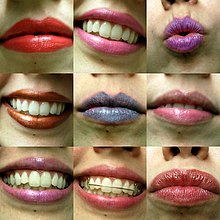Types of cosmetics
Facial cosmetics
The Romans and ancient Egyptians used cosmetics containing mercury.[citation needed]
Foundation
Women of Roman Britain used a foundation made from animal fat, starch and tin oxide.[4]
Lipstick

Lipstick is known to have been used around 5000 years ago in ancient Babylon, when semi-precious jewels were crushed and applied to the lips and occasionally around the eyes. Ancient Egyptians extracted purplish-red dye from fucus-algin, 0.01% iodine, and some bromine mannite, which resulted in serious illness. Cleopatra had her lipstick made from crushed carmine beetles, which gave a deep red pigment, and ants for a base.[5]
The red color of modern lipstick can come from synthetically derived pure iron oxide (one of the components of rust), however most leading brands use the more economical synthetic colors. In the United States, every batch of synthetic dye and pigment must have a sample sent to the US FDA for testing and certification that the batch is pure and its contaminants are below the levels specified by law (Federal Food, Drug and Cosmetic Act CHAPTER VII—GENERAL AUTHORITY SUBCHAPTER B—COLORS LISTING AND CERTIFICATION OF COLOR ADDITIVES FOR FOODS, DRUGS, AND COSMETICS [1]). Synthetic colours are listed in the ingredients as a code (e.g.: F &D red no 6) and may contain up to 10 parts per million of lead / 3 parts per million of arsenic. (Code of Federal Regulations, Title 21, Volume 1 -FOOD AND DRUGS, CHAPTER I—FOOD AND DRUG ADMINISTRATION, DEPARTMENT OF HEALTH AND HUMAN SERVICES, PART 74—LISTING OF COLOR ADDITIVES SUBJECT TO CERTIFICATION) There is some controversy over the presence of these trace ingredients, especially since makeup worn on the lips is not just absorbed through the skin, but also swallowed with drinking and eating. Since lowering these levels would make the production and sale of practically all lipstick illegal, and since the FDA has determined that the existing levels are safe, the cosmetic industry continues to produce and sell lipstick. (Color Additives: FDA's Regulatory Process and Historical Perspectives)[2]
Typically, the pigment is crushed very finely (7 to 10 micrometres) while being mixed with castor oil and is then mixed with a wax base to form a finished lipstick.
Lipsticks may be sheer or dense, matte or shiney. In their thinnest and most fluid consistency they are given their own category, lipgloss.

No comments:
Post a Comment